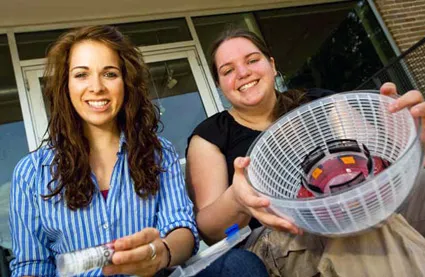Another example of outstanding resourcefulness and ingenuity in the medical community (see earlier this week: Blood Sucking Plunger Could Heal Millions).
Rice undergraduate students Lila Kerr and Lauren Theis use a salad spinner, plastic lids, cut-up combs, yogurt containers, and a hot-glue gun to build a centrifuge, for the low cost of $30. The device is used to manually separate blood without the need for electricity (something of great value to medical clinics in developing countries).

Via Futurity:
"The centrifuge was designed as a project for a global health class. The students were asked to develop an inexpensive, portable tool that could diagnose anemia without access to electricity.
They found that a salad spinner met those criteria. When tiny capillary tubes that contain about 15 microliters of blood are spun in the device for 10 minutes, the blood separates into heavier red blood cells and lighter plasma. The hematocrit, or ratio of red blood cells to the total volume, measured with a gauge held up to the tube, can tell clinicians if a patient is anemic. That detail is critical for diagnosing malnutrition, tuberculosis, HIV/AIDS, and malaria.
'Many of the patients seen in developing world clinics are anemic, and it's a severe health problem. Being able to diagnose it with no power, with a device that's extremely lightweight, is very valuable,' says Rice University engineering education professor Maria Oden."





















Comments
Be the first, drop a comment!